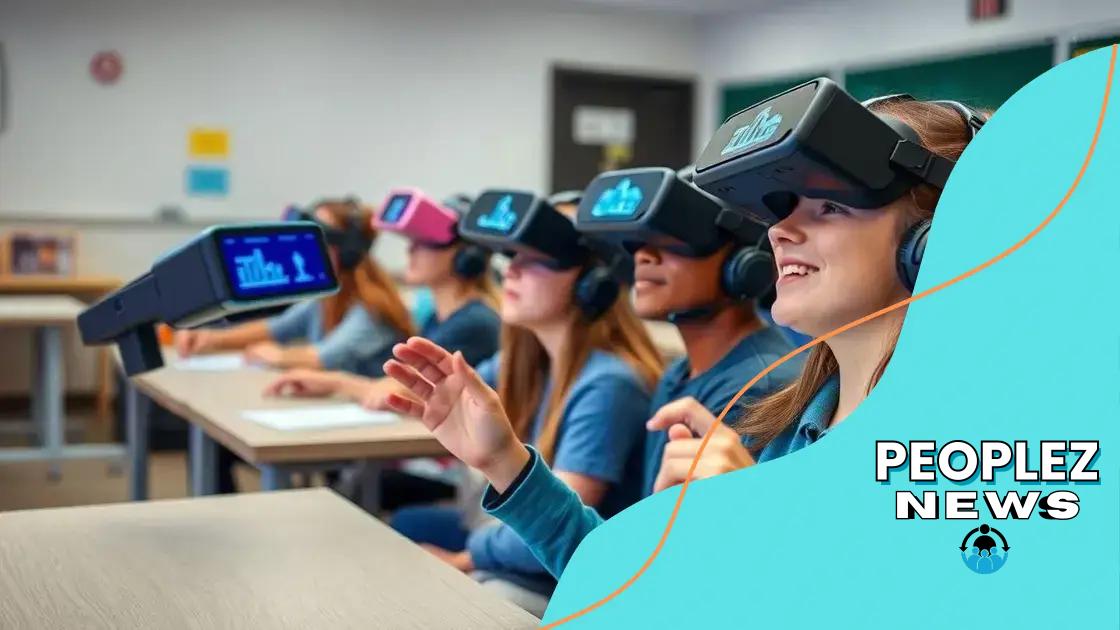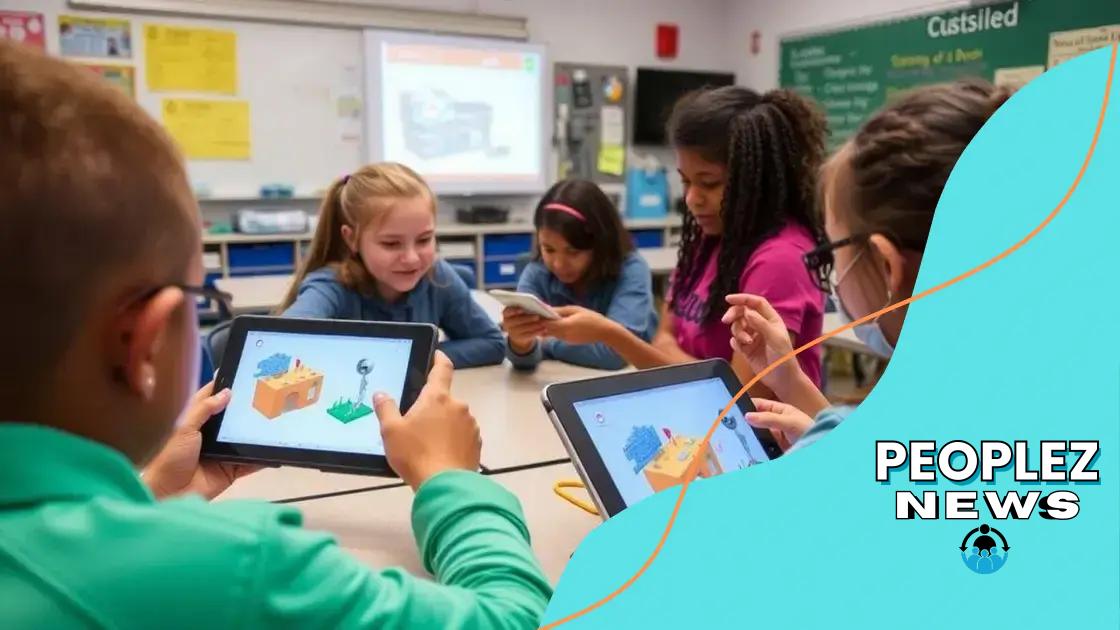How AR is being used for hands-on learning experiences

Augmented reality (AR) enhances hands-on learning experiences by providing interactive, immersive environments that improve student engagement and understanding across various subjects.
How AR is being used for hands-on learning experiences is transforming the way students interact with content. Imagine exploring the anatomy of a frog without a dissection kit. Isn’t that fascinating? Let’s dive deeper into this exciting intersection of technology and education.
Understanding augmented reality in education
Understanding augmented reality in education is crucial for improving teaching methods and enhancing student engagement. AR blends digital content with the real world, creating immersive experiences that can make learning more tangible and exciting.
How Augmented Reality Works
Augmented reality uses technology to superimpose digital information onto the physical environment. By using devices like smartphones and tablets, students can interact with 3D models, animations, and other elements that enrich their learning experience.
Key Benefits of AR in Education
- Enhanced Engagement: Students are more likely to participate when they can interact with content.
- Improved Retention: Visual and experiential learning helps students remember information better.
- Accessibility: AR can cater to various learning styles and needs.
For instance, instead of just reading about the solar system, students can explore it in a virtual space, seeing planets in 3D. This hands-on approach can spark curiosity and make complex topics manageable. Moreover, it can promote collaboration among students as they work together on AR projects, deepening their understanding through shared experiences.
In schools using AR, teachers report that students show more enthusiasm and are eager to learn. By integrating AR into lessons, educators can break the monotony of traditional teaching methods. As technology continues to evolve, the possibilities for using AR in classrooms will only expand.
Benefits of AR for hands-on learning
The benefits of AR for hands-on learning are significant, offering unique advantages for both students and educators. By integrating augmented reality in the classroom, learning becomes more interactive and engaging.
Increased Engagement
One of the primary benefits is that AR captures students’ attention. When students can visualize concepts and interact with digital content, they are more likely to participate actively in the learning process.
Enhanced Understanding
Hands-on learning through AR can simplify complex ideas. For example, students can manipulate 3D models of molecules or historical artifacts, making abstract concepts much more concrete.
- Real-time feedback: AR applications provide instant responses, helping students learn through trial and error.
- Personalized learning: Students can explore topics at their own pace, catering to individual needs.
- Improved collaboration: AR encourages teamwork as students collaborate on projects, leading to enhanced communication skills.
Furthermore, AR can bridge the gap between textbook knowledge and real-world applications. For instance, a biology student can see how the human heart functions in real-time, rather than just reading about it. This direct experience can foster a deeper understanding and appreciation of scientific principles.
As technology advances, the possibilities for AR in education continue to grow. Schools and educators are beginning to explore how they can incorporate this technology into their curricula, preparing students for a future where digital skills are essential. With AR, learning can be more than just memorization; it becomes an exciting journey of discovery.
How AR can enhance engagement in classrooms

Understanding how AR can enhance engagement in classrooms is key to transforming the learning experience. Augmented reality offers interactive, immersive experiences that hook students’ interest and keep them focused on lessons.
Active Participation
One of the notable effects of AR is that it encourages active participation among students. Instead of passively listening to lectures, students can engage directly with digital content. For instance, they can explore historical events or scientific concepts through 3D models, making learning more interactive.
Visual Learning
Visual learning is another benefit of AR in the classroom. When students can see concepts come to life, it helps them understand better. Imagine a lesson on human anatomy where students can view a 3D hologram of the human body. This not only makes the lesson fun but also memorable.
- Collaborative Learning: AR promotes teamwork, as students work together on projects using augmented elements.
- Instant Feedback: Many AR tools provide real-time feedback, helping students learn from their mistakes quickly.
- Gamification: Incorporating game-like elements can motivate students and make learning feel less like a chore.
Furthermore, AR can adapt to various learning styles, accommodating visual, auditory, and kinesthetic learners. This flexibility can lead to increased motivation and a deeper understanding of complex subjects. However, it is essential for teachers to integrate AR thoughtfully, aligning it with their learning goals and ensuring every student benefits.
As classrooms adopt more AR technologies, the hope is to see not only improved classroom engagement but also greater academic success across subjects, from science to literature.
Real-life examples of AR in action
Exploring real-life examples of AR in action helps illustrate its impact on learning. In various educational settings, AR has transformed traditional lessons into engaging experiences. One notable example is the use of AR in biology classes.
Biology Lessons
Students can use AR applications to explore the anatomy of different organisms. For instance, using AR, they can visualize a 3D model of a cell, allowing them to see how organelles interact in real-time. This interactive experience enhances understanding and retention of complex topics.
History in 3D
Another effective application is in history lessons, where AR brings historical events to life. Students can take virtual field trips to ancient cities or historical sites. By interacting with AR content, they gain a deeper appreciation for history, making it feel more relevant.
- AR Sandbox: Some schools use AR sandboxes that allow students to manipulate terrain while viewing real-time topographical maps.
- NASA’s AR App: NASA has developed AR apps that let students explore space missions, including viewing the Mars Rover in action.
- Interactive Language Learning: Language apps use AR to label objects around students, enhancing vocabulary through real-world interaction.
In addition to these examples, AR is reshaping STEM education by offering simulations that allow students to experiment without the constraints of a physical lab. Imagine a chemistry lesson where students can mix virtual chemicals and observe reactions safely. This innovative approach not only promotes excitement but also encourages critical thinking and problem-solving.
Overall, these real-world applications demonstrate how AR can create immersive learning experiences that resonate with students and foster a love for exploration and discovery.
Future trends for AR in educational settings
Looking at the future trends for AR in educational settings reveals exciting possibilities that can transform how students learn. As technology evolves, the integration of augmented reality in classrooms is expected to increase significantly.
Increased Accessibility
One major trend is the growing accessibility of AR technology. With the advent of affordable AR devices and mobile apps, more schools can implement AR tools. This democratization of technology allows a wider range of students to benefit from immersive learning experiences.
Personalized Learning Experiences
Another trend is the move towards personalized learning. AR can adapt content to meet individual student needs, allowing them to progress at their own pace. By analyzing student interactions, AR applications can provide tailored feedback, making learning more effective.
- Enhanced Collaboration: Future AR tools will encourage group activities, enabling students to work together on projects in virtual spaces.
- Integration with AI: Combining AR with artificial intelligence will create interactive tutoring systems that help with personalized learning paths.
- Gamification of Learning: Further gamification in AR applications will make education more fun and engaging, appealing to students’ natural interests.
The integration of AR in STEM education is expected to grow, providing students with virtual laboratories where they can experiment safely. Imagine a chemistry class where students can mix virtual chemicals, observing reactions without any risks. This hands-on approach could enhance their understanding of scientific concepts significantly.
As AR technology continues to develop, its adaptability will improve, allowing educators to create unique and effective learning environments. By embracing these trends, schools can prepare students for a future filled with innovative technology and learning opportunities.
FAQ – Frequently Asked Questions about Augmented Reality in Education
How does augmented reality enhance learning in the classroom?
Augmented reality engages students by providing interactive and immersive experiences, making lessons more memorable and engaging.
Can augmented reality be used for personalized learning?
Yes, AR can adapt to individual learning styles and needs, allowing students to progress at their own pace with tailored content.
What subjects can benefit from augmented reality?
Subjects like science, history, and mathematics can greatly benefit from AR, providing visual and interactive elements that enhance understanding.
Is AR technology accessible for all schools?
With the rise of affordable AR tools and mobile applications, more schools can access and implement AR technology in their curriculum.





